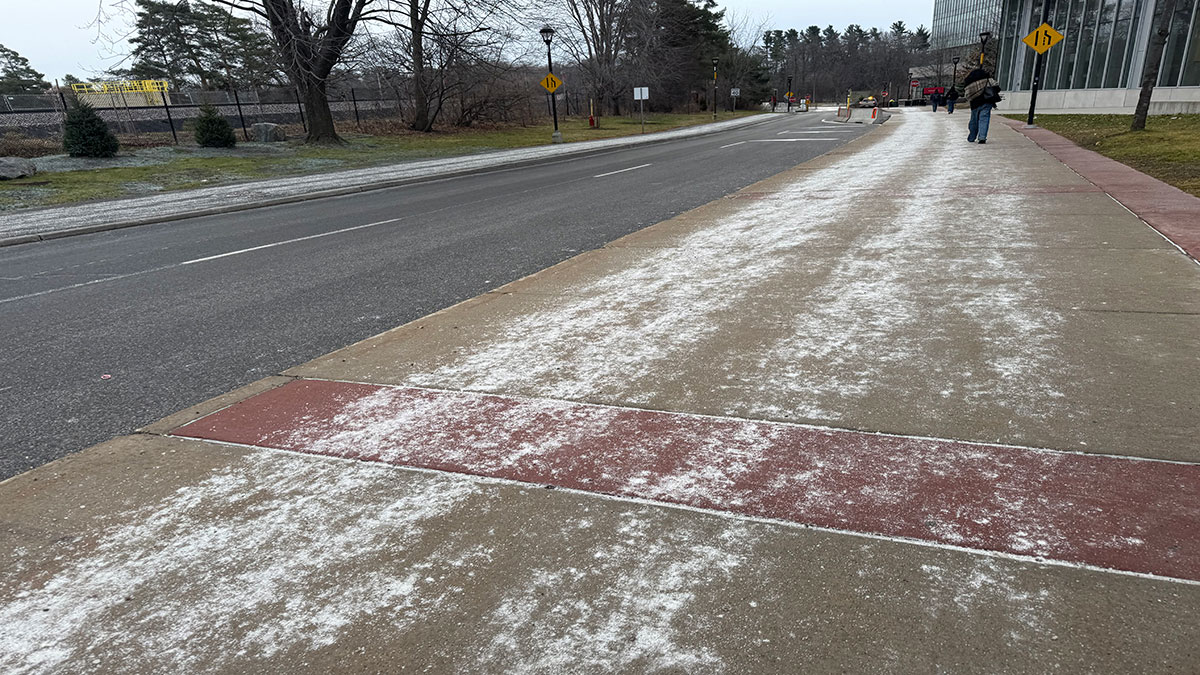On the cusp of another frigid Ottawa winter, efforts are intensifying to reduce the use of de-icing road salt and prevent its toxic impacts on freshwater ecosystems.
Conservation agencies managing the watersheds of the Ottawa River’s two main tributaries on the Ontario side of the national capital — the Mississippi and Rideau rivers — are planning to impose new restrictions on salt use in the region.
This comes at a time when the Ottawa Riverkeeper advocacy group is stepping up its long-running campaign to curb the use of salt and monitor its effects on aquatic ecosystems.
The new policy amendments were proposed for the Mississippi-Rideau Source Protection Plan, an initiative outlining municipal guidelines for the maintenance of clean drinking water. The plan specifically targets significant drinking water threats in areas near surface water intakes and groundwater wells. Among the planned regulations to curb the use and impact of road salt on the environment is a prohibition on storing quantities greater than 300 kilograms.

Despite the lack of snowfall so far in November, road salt has preemptively begun to make its way onto many streets, sidewalks and pathways in the city. The highly anticipated La Niña winter is expected to bring colder and wetter weather, increasing the likelihood of icy conditions. This has many residents, landlords, businesses and public organizations stockpiling salt in preparation for a challenging season.
Despite various environmental initiatives propelling the use of alternatives such as sand and wood pellets to combat slippery surfaces, road salt continues to reign supreme as the go-to way of de-icing — for municipalities and city residents — during the wintertime.
So why exactly is it so bad?
Road salt, or sodium chloride, has been a staple of winter maintenance in Canada for generations. Due to its melting and softening effects on hard ice, road salt is widely considered the most trustworthy substance for de-icing. Cheap and abundant, salt has always been the most affordable solution to slippery sidewalks across the country.
But what price are Canadians really paying for drier, safer roads?
Studies done by Environment and Climate Change Canada have found that in sufficient concentrations, road salts present a significant risk to biodiversity and aquatic environments.

“Chlorides from road salts is a really big concern within fresh waterways all throughout the province,” said Rebecca Kolarich, an Ontario-based water program manager with Environmental Defence, a national advocacy group dedicated to protecting Canada’s lakes and rivers. “These chlorides from salts can transform cool freshwater streams into warmer saltier environments that are toxic for many species and humans.”
Road salt entering waterways doesn’t just affect the stream it filters into, but also the broader web of aquatic ecosystems it’s connected to.
“It’s like death by a thousand cuts,” said Kolarich. “It truly is a domino effect. When one ecosystem gets kind of messed up, it really messes up everything else.”
By changing the chemical composition of the water, road salt can reduce biodiversity overall and disrupt essential life processes in fish, creating complications with reproduction and development.
“It’s not always as dramatic as all fish float to the surface of the water and they’re dead,” said Dr. Dalal Hanna, a freshwater ecologist and Carleton University professor. “It’s akin to us when there was a massive smoke event here last year, nobody felt good when they were outside. Suddenly, your environment becomes uninhabitable. If you’re in this environment that’s really stressful, you may not die, but you’re going to experience all these impacts on your ability to function normally.”

According to Lauren Lawson, a PhD candidate in the department of ecology and evolutionary biology at the University of Toronto, the negative effects of road salt don’t end with their impact on freshwater.
“Besides the water quality impacts,” said Lawson, “it can have really bad impacts on infrastructure, too.”
Excessive salt use can lead to the steady corrosion of metal. It’s also linked to increased rusting on infrastructure, a concern further emphasized by the scheduled replacement of the Alexandra Bridge across the Ottawa River in downtown Ottawa. Commissioned reports reviewing the structural soundness of the 123-year-old link between Ottawa and Gatineau cited an exposure to salt as one of the reasons for its steady deterioration.
“People salt out of care for each other, because you want to keep people safe,” said Lawson, “but at the same time, we are putting at risk our freshwater ecosystems, our infrastructure, our cars, our pets’ paws — everything.”

In addition to infrastructure damage, salt-induced rusting can shorten the life of cars and trucks.
Krown Rust Control is a North America-wide vehicle-protection business that bills itself as a company “committed to continue developing environmentally friendly products that help improve the communities we live in.” The business specializes in rust prevention and solutions.
“Not only is the city using road salt,” said Taryn Almohammadi, manager at the Krown Rust Control shop on Catherine Street in Ottawa, “but they’re actually also using a brine, and the effects are tremendous. People are basically driving vehicles off the lot with rust already on them because of the conditions outside when they’re parked.”
Many advocacy organizations play a crucial role in pushing for a reduction in road salting practices across the city. Among them, Ottawa Riverkeeper is a leading voice for change with its comprehensive road salt monitoring program.
“People salt out of care for each other, because you want to keep people safe, but at the same time, we are putting at risk our freshwater ecosystems, our infrastructure, our cars, our pets’ paws — everything.”
— Lauren Lawson, PhD candidate at the University of Toronto
The program measures the concentration of sodium chloride in different waterways in the region, assessing how much road salt is being filtered into them, and how different ecosystems are being impacted.
The volunteer-led monitoring program began back in 2020, when volunteers were sent to collect samples from “trigger events” — including severe storms when salting was expected to occur — and bring them back for laboratory testing.
Volunteers assigned to specific creeks around the city would monitor their area following major snow or rainfall, and bring back samples to assess how much salt had run off into their waterway.
Over the last few years, the program has been steadily contributing to the Riverkeeper’s sample collection, now comprising five years’ worth of essential data identifying salty hotspots around the city. These are the places where there is especially voluminous salting activity. With this collection, the road salt monitoring program is now ready to usher in a new long-term phase of programming.
Following the expected publication of the Riverkeeper’s first five-year progress report in January 2025, the road salt monitoring program is set to expand its operations to implement consistent long-term monitoring, with volunteers to begin collecting samples every two weeks, regardless of weather conditions.
Another change to the program’s operations will see a shift in testing and collecting equipment, allowing volunteers to test chloride levels on-site by dipping chloride-detecting strips into the water, as opposed to sending samples to the lab.
This will allow the program to expand beyond the 35 sites currently being monitored across Ottawa and Gatineau and produce a better understanding of chloride concentrations in other areas.
Elizabeth Grater, Riverkeeper’s science programs coordinator, said the severity of the salt-pollution problem in the region has driven the expansion of the testing program.

“It’s really not just a winter problem. It is a year-round problem.” said Grater. “By putting those pollutants in these systems, they do find a way to come back to us.”
According to Grater, the damaging ecological effects of road salt in waterways cannot be understated, as they continue to impact a wide breadth of dependent ecosystems that humans benefit from every day. From biodiversity loss to harmful effects on drinking water — road salt puts much of what we take for granted at risk.
“A lot of people don’t feel as connected to the small creeks and even the Ottawa River,” said Grater. “They don’t think about how it can come back to them. It does. It does end up coming back and harming us.”




